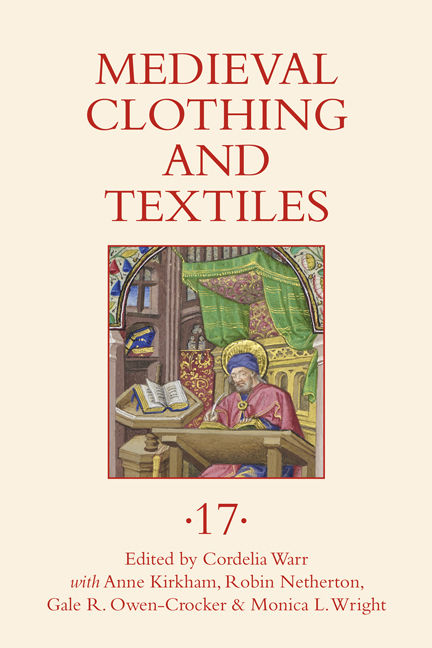Book contents
- Frontmatter
- Contents
- Illustrations
- Tables
- Contributors
- Acknowledgements
- Preface
- 1 Embroidered Beasts: Animals in the Bayeux Tapestry
- 2 The Sleeve from Bussy-Saint-Martin: A Rare Example of Medieval Quilted Armor
- 3 The Administration of Cloth and Clothing in the Great Wardrobe of Edward I
- 4 Hanging Together: Furnishing Textiles in a Fifteenth-Century Book of Hours
- 5 Gilt-leather Embroideries from Medieval Sweden and Finland
- 6 From Hennin to Hood: An Analysis of the Evolution of the English Hood Compared to the Evolution of the French Hood
- Recent Books of Interest
- Author Index, Volumes 1–16
Preface
Published online by Cambridge University Press: 17 December 2023
- Frontmatter
- Contents
- Illustrations
- Tables
- Contributors
- Acknowledgements
- Preface
- 1 Embroidered Beasts: Animals in the Bayeux Tapestry
- 2 The Sleeve from Bussy-Saint-Martin: A Rare Example of Medieval Quilted Armor
- 3 The Administration of Cloth and Clothing in the Great Wardrobe of Edward I
- 4 Hanging Together: Furnishing Textiles in a Fifteenth-Century Book of Hours
- 5 Gilt-leather Embroideries from Medieval Sweden and Finland
- 6 From Hennin to Hood: An Analysis of the Evolution of the English Hood Compared to the Evolution of the French Hood
- Recent Books of Interest
- Author Index, Volumes 1–16
Summary
This volume contains six essays arranged chronologically. Contents extend from the eleventh century to the sixteenth and geographically from England to the francophone world and Scandinavia, covering material remains, art, documentary material, and the value of reconstruction as a research technique. Topics include garments, soft furnishings, and more utilitarian textiles.
Our readers are always interested to learn of surviving medieval textiles, especially little-known ones. Catherine Besson-Lagier accordingly examines a little-known piece of clothing dated between 1160 and 1270 from Bussy-Saint-Martin, France (Chapter 2). Identified as a sleeve associated with medieval padded armor, its shape and composition were documented during its restoration in 1995. The article places this item of clothing in its historical, textual, and archaeological contexts; offers hypotheses on the general shape of the garment to which the sleeve could have been attached; and presents the results of experiments with the creation of such a garment that takes account of the technical characteristics of the original sleeve and argues for the value of reconstruction as a research methodology.
Moving from this obscure medieval textile to the best-known of them, the embroidered Bayeux Tapestry, and focusing on the more than 700 animals depicted in the Tapestry's main register and borders, Gale R. Owen-Crocker (Chapter 1) notes that whilst many of them are recognisable types, remarkable for their vitality, they are not spontaneous creations from life. Rather, they are very dependent on earlier textile art and recent manuscript models and, in addition, were constructed with templates. The author suggests that many of the animals are not merely authentic accessories of medieval life (in the main register) or decoration (in the borders) but that they provide subtle clues to human emotions and motivations in the power struggle which the Tapestry depicts.
Continuing the focus on embroidery, Amica Sundström and Maria Neijman investigate a group of medieval Scandinavian textiles which they call gilt-leather coverlets, after the narrow gilded strip of leather used to decorate these embroideries (Chapter 5). The preserved objects have been used in churches, but written sources show that they were present in secular environments as well. The combination of materials, techniques, and design makes these embroideries unique to medieval Sweden and Finland. The authors describe the preserved objects and show how reconstructions of them can create a deeper understanding of their construction and expression.
- Type
- Chapter
- Information
- Medieval Clothing and Textiles , pp. xv - xviiiPublisher: Boydell & BrewerPrint publication year: 2023

